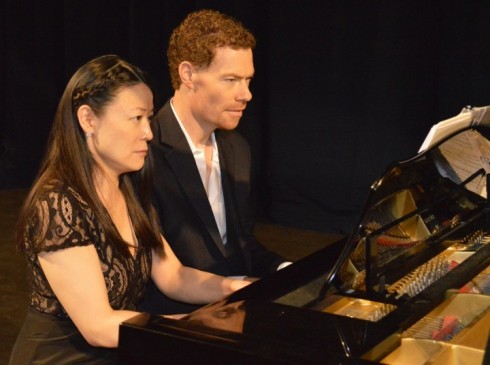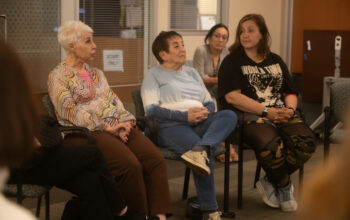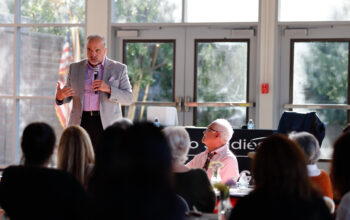Seated at a single piano in the center of the stage, Frank Garvey and Yih-Mei Hu began a performance that made clear why the duo chose the name Dances for Four Hands.
In a show of collaboration and synchronization timed to a fraction of a second, the duo played as one, switching places on the bench between measures. Hu and Garvey, each a highly accomplished and accredited pianist, chose five pieces for their Thursday Concert Series performance centered around the theme of international classical dance music on May 14.
“Our program today is a whole program of dances from around the world,” Garvey said. “We’re taking a world tour from chilly Norway all the way down to sunny Argentina.”
The first piece the group played was “Anitra’s Dance,” written in 1876 by Edvard Grieg. The piece was mischievous and playful, almost childlike. It started slow, but the pace picked up as Garvey and Hu played in perfect harmony.
After “Anitra’s Dance,” the duo played “Five Spanish Dances, Op. 12,” written by 19th-century Polish composer Moritz Moszkowski. In five measures, the piece ran the gamut in terms of the mood it set. The first movement, Allegro Brioso, was lighthearted and carefree, reminiscent of an aristocratic ballroom dance. The second movement, Moderato, was slow and contemplative, but not in a somber way. Garvey played the low end, and Hu the high, but unless a person were watching, it would require a trained ear to distinguish that there were two pianists playing simultaneously.
Garvey said he has developed a list of short mnemonic devices to help him play in tandem with Hu, which he confirmed is as hard as it looks.
“These are literally some of the words I have written in my score,” Garvey said. “Run, hide, get high, low, hover. At one point in my score I have ‘obnoxious Frank, stay low and out, watch Y,’ meaning Yih-Mei, followed by sniff and bounce.”
Bolero con Spirito, the fifth and final movement, was exceptional in its beauty and execution. Hu again played the higher notes, making them sing throughout the piece’s festive finale. She played with lightning speed, and with Garvey setting the tone and rhythm on the low notes, it was hard to believe the sound all came from a single piano.
In Cortege, the second movement of “Petite Suite” by French composer Claude Debussy, the duo again played in such unison that there was almost no way to tell which was which. The piece was incredibly intricate and synchronized perfectly. The two often played closer to the middle, touching elbows as a way of maintaining position, and the sight and sound of it gave the listener the impression they were actually one in both mind and body.
The final piece of the performance was “Libertango,” a contemporary tango written by Argentine composer Astor Piazzolla in 1974. The piece was fast and loud, with a somehow mysterious tone that would break into erratic intensity, speeding up and slowing down throughout. Garvey and Hu took the chance to show off during the piece by standing and switching seats repeatedly, taking turns playing the high notes, which took lead in the piece.
Hu said the program took them months of practice to be able to play fluidly.
“We’ve been working on the program for about six months and we’ve played it several times at different places in L.A.,” she said. “With every performance, we find new things to work on, so it’s sort of an endless process.”
The last piece, “Libertango,” was particularly well received by audience member Donna Hemans.
“I liked all of it, but the first piece and the last — the last was exceptional, really I just loved it,” said Hemans, a music major. “The swiftness in her [Hu’s] fingers, just wonderful. I think they made a good combination together.”
The next Thursday Concert will feature a performance entitled Music for Strings, and will be held on May 21, at 12:45 p.m. in the Performing Arts Building.



